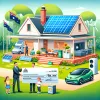Savings as a Service - Issue #6
We’ve launched Bill Hero for Business! This has been one of the biggest requests since we first released the Bill Hero residential service.

Hi there,Welcome to the April edition of Savings as a Service. It’s been another big month for Bill Hero and for the retail energy industry in general, and we’re here to tell you all about it.
We mean business
We’ve launched Bill Hero for Business! This has been one of the biggest requests since we first released the Bill Hero residential service.
We’re offering a 20% discount for Business subscribers for the month of AprilTo access the discount, just signup to Bill Hero for Business and use the discount code BIZLAUNCH.
Buy Green the smart way
We’ve added GreenPower into the pricing algorithm for our residential electricity service. GreenPower is a government scheme that allows you to buy renewable electricity, and support renewable generation, by voluntarily paying a bit more per kWh in your electricity bills.‘How much more’? I hear you ask. ‘And does that extra money really go to renewable generation’? Well, the answers are, ‘it depends’, and ‘partially’.We’ve done the research, and you probably will not be surprised to learn that GreenPower is yet another area where retailers work hard to bamboozle customers to their own benefit:
- Even the least ‘green’ of the retailers actively promote GreenPower plans
- There’s a 400% difference between the best and worst price charged for the GreenPower price uplift per kWh
- We’ve also found that many retailers are aggressively gaming the market mechanisms, to maximise their own benefit from your GreenPower investment.
Our new GreenPower capability makes it easy to see the price impact for the various levels of GreenPower available, and allows you to maximise the impact of your GreenPower choice, while minimising the cost. Now you can support renewable generation the smart way, not just support your retailer.
We reckon our GreenPower comparison, coupled with the Green Ratings feature that we launched last month, makes Bill Hero by far the best Green energy comparison service in Australia.
Bill Hero means business
Feature story
Since we first launched Bill Hero, our subscribers have consistently asked for the same service to be made available for their businesses. Finally, we can announce that it’s ready.

Bill Hero for Business brings the unique Bill Hero Savings as a Service proposition to SME business electricity accounts, including always-on bill monitoring, automated analysis, personalised comparison and switching support to help make sure that your business will never overpay for electricity again.
The retail energy regulations distinguish between ‘Small’ and ‘Large’ electricity consumers, and Bill Hero for Business handles ‘Small’, or SME business electricity accounts only. If your business qualifies as a ‘Large’ electricity consumer, then there’s no published prices available for Bill Hero to work with, and you’ll need bespoke brokerage services to get the most competitive deals. We don’t offer those brokerage services directly, but we can refer you to trusted partners who do.
It's even easier to be Green
Last month, we launched our Green Ratings feature, which displays the Green Electricity Guide star rating for every retailer in the Bill Hero results. You can filter your results by Green Rating, so you can more easily choose plans from retailers that meet your Green expectations and requirements.
This month, we’re launching a complimentary feature to include GreenPower pricing in the Bill Hero comparison. GreenPower is a government program that allows energy consumers to buy renewable electricity, and support renewable generation, by voluntarily paying an additional price uplift on the electricity they consume.

GreenPower is marketed as a way for you to financially support renewable generation, however there’s no correlation between the GreenPower prices set by your retailer, and the amount of money that ultimately makes it to the renewable generators you’re trying to support.
We’ve found that some retailers blatantly overcharge GreenPower buyers – presumably because they consider any buyer willing to pay extra is fair game for gouging.
The most expensive GreenPower pricing in the market today is 400% more expensive than the cheapest on offer.
Overpaying for GreenPower only rewards the retailer, so even if you’re willing to pay above the odds to support renewable generation, it absolutely makes sense to find and stay on the best priced GreenPower plans available.
Our new GreenPower pricing tool does exactly that, and supports you as a Green energy consumer to find and buy the plan that will deliver the full benefit to renewable generators at the lowest cost to you.
Retail energy news
Coal prices are on the rise, leading to a sharp increase in futures pricing for electricity. After about two years of decline, retail electricity prices are now expected to go up. Unsurprisingly, the price increases will manifest in consumer bills much more quickly than the wholesale price savings were previously passed through.
Now more than ever, it makes sense to switch to the best priced plan you can find.
Queensland braces for second energy shock as coal price pushes up power costs
The rising coal price is set to cause a second energy shock for Queensland with power prices tipped to rise sharply.
We’ve all been pretending that summer is not over, but it’s now undeniable – the cooler weather is here, and it’s time to get prepared for the cold months ahead.
Here’s our recommendations across the four main energy consuming elements of your home, to keep your energy bill under control in the face of increasing consumption and increasing prices through the colder months ahead.
Heating (about 40% of home energy use)
- Only heat the areas of your home that you’re using. Shut doors to unused areas, and keep the heat where you’ll feel it.
- Stopping your warm air from escaping is the cheapest and most effective way to minimise your energy bill. Use draught stoppers to prevent air leaking under doors. Apply weather seals to your windows, skirting boards, skylights and cornices.
- Minimise heat loss through your windows with curtains and blinds which trap an insulating layer of air next to the glass. Open your curtains to let the sun in during the day and close them before it gets dark.
- Use your ceiling fan in ‘winter mode’, or reverse, to reduce heating costs. Heated air rises to the ceiling. In reverse mode, a ceiling fan will draw up cooler air from the room below. This pushes the warmer air out and down the walls to recirculate into the room which improves heating efficiency.
- Set your heating thermostat to between 18°C and 20°C. For every degree you increase heating, you’ll increase your energy use between 5% and 10%.
Hot water (about 25% of household energy use)
- Set your thermostat to 60°C for storage hot water systems and no more than 50°C for instantaneous systems. It’s a waste of energy to have scaldingly hot water that needs to be mixed with cold before you can use it.
- Your hot water likes holidays too. If you’re away for more than a week, turn off your storage hot water system and save money and energy.
- Install a water-efficient shower head. A 4-star rated shower head could save a family of 4 around $315 a year on water bills, plus you’ll also save on energy bills because less water will need to be heated.
- Do your research ahead of time so that when your hot water system inevitably fails, you’ll be ready to replace it with the most energy-efficient model available – this will usually be a heat pump system.
Appliances (about 30% of household energy use)
- Use the Energy Rating website to compare running costs of appliances.
- Always buy the most energy-efficient appliances you can find. The savings can easily add up over the life of the appliance to outweigh the purchase price.
- Use your appliances efficiently. For example, washing clothes in warm water can use up to 10 times more energy than a cold wash.
- Reduce standby power. Many appliances use power, even if not in use. Turn them off at the plug.
Lighting (between 8% and 15% of household energy use)
- Use natural light wherever possible.
- Use lights efficiently. Use reading lamps rather than lighting a whole room. Switch lights off when you leave the room.
- Switch to energy-efficient lighting. LEDs use around 80% less energy than incandescent light bulbs, and they last longer too.






